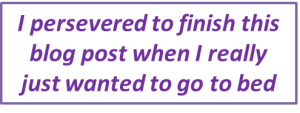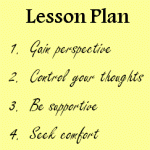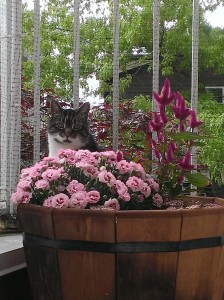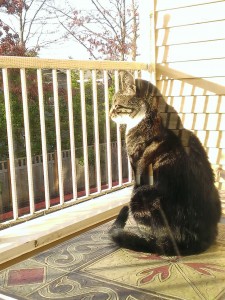Living Your Values
What I Learned About Business from Improv Acting Class
 A few months after I quit my corporate job, I signed up for an eight-week improv acting class. We met for two and half hours on Wednesday evenings at a community center where we practiced improv techniques. I realized that much of what we learned applies to business.
A few months after I quit my corporate job, I signed up for an eight-week improv acting class. We met for two and half hours on Wednesday evenings at a community center where we practiced improv techniques. I realized that much of what we learned applies to business.
Three improv lessons are especially useful:
- Yes, and
- Commit
- Know When to Exit
Yes, and
In improv, this means you go with the direction your improv partner has started in order to keep the scene going. Cooperating and adding to the foundation that your partner set is what builds the story line and keeps the momentum going.
In business, if you were taught best practices in brainstorming sessions, you have already learned this. What it means is that when someone makes a suggestion, you say “yes” and then add your idea about how to make it even better. That way, whether you think their idea has merit or not, you’re keeping the positive flow of ideas coming and contributing in a positive way.
Commit
 In improv, once you enter the scene as a space alien coming to kidnap Santa Claus, you talk and act like a space alien on a mission to get Santa. If you get embarrassed and limp through your scene, it isn’t going to be enjoyable for you or the audience. If you decide you don’t want to be a space alien and try to change to something else, then you’re screwing up the scene for your partner who is playing Santa.
In improv, once you enter the scene as a space alien coming to kidnap Santa Claus, you talk and act like a space alien on a mission to get Santa. If you get embarrassed and limp through your scene, it isn’t going to be enjoyable for you or the audience. If you decide you don’t want to be a space alien and try to change to something else, then you’re screwing up the scene for your partner who is playing Santa.
In business, this boils down to deciding what your objective is, how you are going to execute upon it and then doing it. Being unclear about your objective confuses the people who need to take action. Changing tactics midway through projects wastes time and money.
Know When to Exit
In improv, sometimes an actor says a great line that is a perfect finish to the scene. The audience laughs and everyone recognizes that it’s complete. That is the time to exit and let the next scene begin fresh. Any added words or actions after that point dilutes the powerful impact that was made and it becomes less funny.
Another time to exit the scene in improv is if the scene isn’t going anywhere, it is dragging on, and the players can’t seem to fix it. The best thing to do in that case is wrap it up and move on to the next scene.
In business, there are many great applications to this lesson. You’ve won the client’s business: now shake hands and get out of their office. You’ve agreed upon next steps in the meeting: close up the laptops and get back to work. You had a great success with a product promotion that has now ended: take the lessons learned and move onto the next promotion.
And in the case of the project not going anywhere…knowing when a product or program is not viable is much more valuable than trying to force it to happen. Accept the sunk costs and move on.
This can also be applied to a job. When it becomes clear that your job is not going the way you need it to, making the decision to exit could be the best way for you to bring the scene to a close on your own terms.
Perseverance Trumps Positive Attitude
 We hear so much about how important it is to have a positive attitude. I think it is helpful to remind ourselves of what we’re grateful for because it keeps us from dwelling on what’s wrong, generally makes us feel more content with our lives, and because Oprah does it every day. Seriously! I recently went to her “Live The Life You Want” event and she credits her daily gratitude practice as part of her success.
We hear so much about how important it is to have a positive attitude. I think it is helpful to remind ourselves of what we’re grateful for because it keeps us from dwelling on what’s wrong, generally makes us feel more content with our lives, and because Oprah does it every day. Seriously! I recently went to her “Live The Life You Want” event and she credits her daily gratitude practice as part of her success.
I believe that choosing to focus on thoughts that are useful versus ones that drag us down makes sense. In my own recent experience with losing my beloved cat, consciously choosing to think that I made the best decisions possible at the end of his life has helped me cope.
I also believe there is merit to the law of attraction. Sometimes I seem to manifest whatever I’m focused on, for good or bad. I try to keep it positive so that I’ll manifest great things like my beautiful Dodge Challenger!
However, I don’t think that a positive attitude ensures we will only attract beneficial things into our lives, or that we can force our minds into thinking we’re happy when really we’re not. That would be arrogant, wouldn’t it, to think we controlled everything that happened to us!
During those times when circumstances are tough – when we’re facing a big problem, struggling with relationships or health or whatever the situation is – perseverance trumps a positive attitude. Thinking brighter thoughts might help. But perseverance is what gets us out of bed to eat and shower and get to work when we don’t feel like it. Perseverance pushes us to meet our obligations. Perseverance is what keeps us going one day after the next until we’ve made it through that tough time.
Clearing Your Mailbox Reveals Where You’re Stuck
Yesterday was one of those hectic days when I juggled meetings, appointments and phone calls while my most important task didn’t get addressed until evening. I owed a new client a document that I was excited to work on. I could have approached the project many different ways, and all day long it was in the back of my mind.
Yet when I finally finished my meetings and had time to focus on the document, I did something else first: I cleaned out my mailbox.
I didn’t just deploy the Clean Up feature – I spent an hour overhauling Outlook. I already had a good folder system in place, but was bogged down by hundreds of old mails. By the time I finished, I’d deleted over 600 mails, archived folders that I didn’t want to see anymore, and realized that cleaning out a mailbox can reveal a lot.
Emails that you want to keep but haven’t filed reveal the topics that don’t fit neatly into the rest of your life. Email you haven’t responded to shows what you’re avoiding.
Are you ever going to reread those old articles or click again on the links to interesting websites? If not, it is time to let them go. But if those emails are full of tips that you can use, or ideas for your business then it is time to make a new folder for “Tips” or “Business Ideas”.
Cleaning out my mailbox showed me where I was stuck. When I was finished I felt lighter and energized, like I had freed up wasted space in my mind. I believe visual clutter leads to mental clutter whether the clutter is physical or virtual bits of data clogging up your PC.
When I finally started working on my client’s document, I quickly decided how to approach it and the project flowed smoothly. This afternoon the client told me I’d exceeded his expectations. That’s one of the best compliments I can hope for as a consultant.
I’m going to remember this the next time I want to have a clear, focused mind to start a new project. The first step will be to create space for it.
Still Using Your Company Email Address for Personal Business?
![]() Last week Microsoft announced another 3,000 layoffs. The news inspired me to check out the Mini-Microsoft blog that used to be a great gut-check of the view inside the company. It is largely inactive now, but as I scrolled past comments about the layoffs back in July, one of them caught my attention.
Last week Microsoft announced another 3,000 layoffs. The news inspired me to check out the Mini-Microsoft blog that used to be a great gut-check of the view inside the company. It is largely inactive now, but as I scrolled past comments about the layoffs back in July, one of them caught my attention.
The anonymous commenter had a great perspective. He acknowledged that while being laid off hurt, he was going to view it as an opportunity to discover what else he wanted to do. He closed by saying “I think it also may be healthy for me to not have my identity associated with my MS email address.”
Yes.
If you use your employer’s email address for your personal use, every time you hit “send”, you’re associating your personal identity with your place of employment. You’re signaling that you, as a person, are tied to your company even for personal matters.
If your identity is tied up with your employer, your job title, or the type of work you produce, it is smart to start building up your sense of yourself that is separate from work. This is a good thing to do anyway, but it is especially important if you’re about to leave a job. If you’re not prepared, you could slip into an identity crisis.
If you are using your work email address for personal business, make the change. Retrain your friends and family to use a personal address.
You are more than who you’re employed by.
Do it Anyway
 One of the students in my Emotional Intelligence class told our group about her childhood. She had tough experiences growing up, and continues to deal with challenging family issues. She talked about feeling overwhelmed at times.
One of the students in my Emotional Intelligence class told our group about her childhood. She had tough experiences growing up, and continues to deal with challenging family issues. She talked about feeling overwhelmed at times.
Her situation was unique, but I can relate to it. Don’t we all have something challenging in our pasts that we had to work to overcome? Don’t we all face situations from time to time that drag us down?
It’s what she told us next that stuck with me. She talked about volunteering with groups that help disadvantaged women and said she does it even when she feels sad. She contributes and gives support to others, even when she is grieving her own losses.
She felt sad and did it anyway.
A few days ago I read an article by Scott Dinsmore about fear. He talked about being paralyzed by doubt when he sat down to develop a new course. He talked about nearly cancelling a workshop that he had already advertised because when he tried to create the materials, he choked.
Then he wrote something really interesting. He said that when he completed those programs, he was proud of the way they turned out, and that he considers them the most significant work he’s ever done. Wow.
He was afraid and did it anyway.
This week I gave a short presentation to a local Rotary group, on the topic of preparing to quit a job. It was a great experience – the Rotarians were gracious and I enjoyed the chance to connect with them. Plus, it was fun to speak about what I’d learned from all those hours of research. But leading up to the event… I was tired!
I had some of the Scott Dinsmore-styled fear, and am still grieving the loss of my beloved cat. But what really threw me off balance were two weeks of personal mayhem. Unexpected events consumed much of the hours and energy that I planned to use on preparing for the talk. Instead, I was on edge and sleep deprived, but I chose to work through the fatigue to narrow my topic, review my slides with friends and rehearse.
I was tired and did it anyway.
It doesn’t mean that we should keep pushing ourselves nonstop. Now that my presentation is done, I’m resting more, drinking immune-system-building tea and scaling back on social events while I regain my energy.
I’m a big believer in giving ourselves breaks. I think we should overcome the pressure to operate like robots, and stop congratulating ourselves when we ignore the need to rest and recover. But there’s a difference between relentlessly pushing ourselves past healthy limits and taking on specific challenges that require extra effort. Sometimes a goal or activity is worth the exertion required to get past obstacles like sadness, fear and tiredness.
The next time I have a big opportunity in front of me, one that is worth going after, I’m going to acknowledge how I feel about it. I’m going to think of ways to maintain my health while I pursue my goal. And then I’m going to —
do it anyway.
Hard Lessons
These are lessons I didn’t want to learn. If the tradeoff was having Milo with me or knowing what I know now? I’d pick my cat. Of course I would.
But life doesn’t work that way, so I figure that the only thing worse that losing him would be to not learn anything from it.
The first lesson came when my cat started showing symptoms that were later diagnosed as thyroid disease and lymphoma. I fell apart every day. Sometimes multiple times in a day. By falling apart I mean crying, and moments where my energy drained out of me and all I wanted to do was lay down.
Then I decided that I didn’t want to live like that anymore. With chemotherapy and his other medicines, it was possible that he would have lived for up to three more years and I didn’t want to be depressed that entire time. I made a choice not to make his illness the center of my life. I had a book to finish, relationships to care for and work to do. When he died, that choice became not making his death the center of my life.
The second lesson I learned is that I can control my thoughts. We hear a lot about this – the power of positive thinking, we create our own realities, blah blah. At different times in my life I have tried to consciously choose my thoughts but it wasn’t that effective. I also had some scorn about people trying to brainwash themselves into believing they were better off than they actually were. It seemed unauthentic.
Soon after Milo died, I felt a tremendous sense of guilt and regret. Not about euthanasia at the end. I regretted that I hadn’t rushed him to the ER sooner after he started going downhill the last time. He stopped eating and drinking and I waited, thinking about how stressful the hospital was and how much he hated it. I waited, wondering if would be better to let him die at home than put him through more intervention. I waited, asking myself how many times we were going to do this. Then the decision got past me, and by the time I took him to get fluids, it was a hospice mission.
After he was gone, I wished I could go back in time and make a different choice. I kept thinking, “if only I had taken him to the hospital sooner, would he still be alive?” These thoughts were so painful that I had to stop them. I realized that they didn’t serve me – they only caused me to suffer, and they didn’t honor Milo’s life. I made myself acknowledge that there is no way of knowing if he would have lived longer, and that thinking I made the wrong choices was just one story. Another story is that I did the right thing. Possibly more treatment would have been worse for him, or he might have died there, in the place he hated, away from me.
The “if only” thoughts still came, but when they did, I forcibly stopped them. As soon as I caught myself, I would think, “NO!” And then tell myself, “I choose to believe the possibility that I made the right choices.” At first this scenario played out repeatedly. After a while, less so.
The third lesson was that the support I received taught me how to support others in grief. One friend called me the evening that Milo passed away, and just listened. She invited me to go out the next night, and getting out and doing something helped. Another friend came to my house the next day with a plant, and the formalness of it made me feel like we were memorializing Milo. Receiving cards and reading messages from people on Facebook also helped.
In the past, I wasn’t always one to reach out when someone else experienced a loss. I might have been unsure if making contact was welcome. What if they wanted to be alone with their grief? Or I felt unsure of what to say and then didn’t reach out at all. After being comforted by other people’s gestures, I decided that even if I didn’t know what that person wanted, it is better to send an email, a text or make a phone call than not.
The last lesson I’ve learned is to look for support and comfort. Besides accepting help from my friends and family, I took action on my own. I read articles online about grieving animal companions, and found a weekly candle lighting ceremony at www.petloss.com. Each Monday, people across the globe gather online to read a prayer for our animals and light candles to honor them. When the ceremony isn’t taking place, people can use the chat room to seek support from each other.
A few days ago, a blog that I subscribe to included a post called Moving Beyond the Pain of Losing Someone You Love. The author, Karen Lang, wrote about the tragic loss of her son and how for a period of time she doubted the choices she made at the end of his life and was consumed with wondering “what if”. Although our losses are different, she expressed what I had been feeling and that was reassuring.
I also happened to get an email with a link to a podcast that featured Christina Rasmussen, who wrote a book called Second Firsts: Live, Laugh, and Love Again. Normally I have no patience for podcasts, but I listened to this one twice. She uses science to support her theories and talked about the importance of giving ourselves time to rest and recover when we’re hurt: she calls this “the waiting room”.
No matter what I have going on in my life, I feel self-imposed pressure to complete my self-imposed deadlines for work and writing. When I take breaks or try to get extra rest, I often wind up feeling more anxious instead of energized. Rasmussen’s message pointed out that allowing myself downtime is more helpful than slogging through my to-do list.
None of these lessons are worth what I lost. But they’re better than not learning anything at all.
Breakup Songs for Cats
I was listening to a This American Life podcast one August evening this summer. The topic was breakups.
It made me think about a particularly bad breakup that took place in August years ago. And then – ugh, I put it out of my mind because while I’m happy with my life and grateful for the way things turned out, at the time it was devastating. There’s no need to dredge up old pain.
After the podcast ended, I went to the kitchen to get a glass of water and check on Milo. I saw him lying under a chair, a pile of fur. He didn’t even look like a cat. Just a mess of puffed up, black cat hair. When I stepped back into the living room he was sitting up, watching me.
I whispered, “I’m coming to get you,” and starting walking towards him slowly with big, exaggerated steps and my arms up like Frankenstein. I paused, “I’m going to kiss your head,” then moved closer. When I was four feet away, I could hear him purr. I started crying, but kept going until I smooched his head anyway.
It made me think there’s something missing in the genre of songs about the loss of love. I haven’t heard any about the loss of a pet. The pain is deep and aching, and is something that so many of us go through. So why not?
One segment of the podcast was about a woman who was so immersed in breakup songs that she wrote and recorded one of her own to help deal with her loss. Much of the sentiment in songs about broken love touch into the same heartache over the thought of losing Milo. There’s disbelief and aching sadness. There’s a flood of memories. There’s a feeling that a very real piece of me is being cut away. The worst feeling is the one that hits me when I go about my day and suddenly remember that he’s sick, and that someday, even if he made it through this illness, he’s going to die. That remembering – it’s a sudden shock that pounces on me, over and over.
Life changes so quickly. One thing I could count on was that every time I walked through my front door, Milo would be home, waiting for me. When I was grieving the deaths of family members or the endings of relationships, he was a consistent source of comfort. Through the upheaval of quitting my job and the neurosis of writing a book and the ups and downs of starting a business, he has been there. For nearly twelve years, Milo has been there.
I told him, “Don’t leave me. I need you.”
He’d been sick since the end of June, vomiting and not eating much, and dropped from an already tiny ten pounds down to seven. In July, he had to stay the night at the hospital for the first time. It was after 11PM when I went home without him, walked into my house and noticed all the markers of his life there. His food bowl, scratching post, toys. Cat hair on the edge of my blanket.
I got up early the next day to drive to the hospital to check on him. He was much better. He was alert and busy checking out the exam room. He ate some food and tried to scratch the cabinets and the seat covers. I stopped him, but appreciated his willfulness. He kept a wary eye on the door.
Once home, he would get better and then he would get worse. He was diagnosed with lymphoma in the intestines. His twice daily medicines were adjusted. We grew to hate the many trips to the hospital, although I’m grateful for their care. The good days went by so quickly. The bad ones stretched out painfully.
A couple of weeks ago, he lay next to me on the couch, his back against my stomach. This is my favorite way to sit close together, but not his, so whenever he curled up next to me I held onto the moment as long as I could.
Some web sites say indoor cats average 12 – 18 years. My vet used to say he could live into his twenties and that is what I’ve expected. Twelve is not long enough.
The prognosis for his cancer is up to three years. My attitude changed. I’ll take three more years. Three more years is great. Please give me three more years.
I want a love song for my cat. And for all the brokenhearted women and men like me. Where’s our song about knowing he’s going to leave and not wanting to accept it? Where’s the song for after he’s gone, when all that’s left are the tufts of fur in the corners of the room?
Milo passed away on Friday with the help of our home vet. In his last few days he stopped making his adorable meow-els, but he gave me one last purr as we said goodbye.
It was a life well lived. A life well loved.
Letting Go of Treasures
I tell people that after my grandparents died they came to live with me. My grandmother passed away in September of 2011, and my grandfather a few months later. I had a special connection with each of them and “sad” doesn’t begin to describe how I felt when they were gone.
The grieving process was long.
Managing their affairs was complicated.
My father and aunt had already passed away and so my grandparents entrusted me to manage the “death responsibilities,” as I call them. “Managing an estate” sounds like something a New York banker does for his millionaire clients. Death responsibilities are not glamorous. They included combing through files to locate every utility to change into my name until the house could be sold. They included cancelling subscriptions to magazines and newsletters.
Death responsibilities included standing in the middle of a home full of vases, record albums, tables, chairs, and boxes of dolls and doilies and wall hangings. Taking inventory, stacking boxes for the Goodwill, and bagging up load after load of half-empty bottles of aspirin, bug spray and chipped flower pots to take to the dump.
It was overwhelming.
It was heartbreaking.
My grandparents moved many times throughout their lives. My grandma started on a farm in North Dakota and her adventurous spirit took her to Washington, Hawaii, California, and finally to Oregon, with a brief experiment in Arizona along the way. My grandfather, who is actually my step-grandfather, also lived in many different places during his military career and then was along for the ride with my grandmother.
Each time they moved they brought all their old stuff with them and acquired new things. Each new house seemed to have more cupboards, more closets, more garage space. They weren’t hoarders. Their homes didn’t have stacks of papers or piles of stuff strewn everywhere; their possession were neatly stored. They just had a lifetime worth of belongings stuffed into every available space.
They cherished their belongings for the memories, and also held onto things out of a desire not to waste. They both had grown up in circumstances that required thrift.
Their belongings weren’t especially valuable. They were just plentiful. I took an entire trunk worth of jewelry to be cataloged and appraised, and dutifully wrote down “$0” next to each item’s listing as the jeweler told me “Costume jewelry, no value” over and over. It is true that most of the baubles were not made of precious metals or stones. From an estate inventory point of view, they were not worth anything. But they meant something to my grandma. They were gifts or handed down from her mother or purchased with her hard earned money. And because of that, they are worth something to me, too.
The last piece of jewelry that she received was a gift from me. Knowing her love for big, opulent pieces, I picked out a Stella and Dot ring with a swollen cluster of faux pearls, and brought it with me on one of my visits to see her. She was happy.
For a while I wore my grandmother’s jewelry every day. I set about ten of her necklaces and rings in my own jewelry box. But there is too much of it, an overwhelming amount, and the rest of it is hidden deep in a closet. Someday I will go through it again and decide what I truly want to wear and keep. And the rest of it…the tattered bracelets and faux diamond rings…I guess they will go to the Goodwill.
My grandmother had distinct taste. I loved that about her. And now I have what may be the world’s only brass chandelier painted over in a color best described as a cross between a muted turquoise and powder blue. I also have the leopard print chairs that she bought for her lanai when she lived in Honolulu. I have a photo of my dad sitting on one of those chairs during an R&R break from Vietnam.
Knowing how much they valued their possessions made it difficult to get rid of them. My relatives took some objects – paintings, a chair, a lamp, the computer, photos. I took the most belongings, a small trailer’s worth.
My grandfather had a silhouette painting on his bookshelf. Inscribed on the back was “From Daniel to Nana on Mother’s Day, May 1939.” If he had kept this treasure for 75 years, how could I give it away now? I have mixed feelings. I don’t want to be the keeper of the family heirlooms. Yet I feel obligated to keep these things.
My preference is to have minimal stuff. I don’t like having a lot of decorations in my home. I can’t stand visual clutter. The words “knick-knack” and “trinket” bother me.
I wanted my grandparents with me. After they passed away, the closest thing to having them with me was to surround myself with their belongings. My living room now has more objects that belonged to my grandparents than anything I acquired on my own.
It has been three years since they died. I’ve begun to think it is time for my grandparents to move out. My minimalist tendencies are getting stronger along with the desire to reflect my own style instead of living in a shrine.
One piece of furniture that I inherited is my grandfather’s armoire. It has four shelves and a glass door that locks with a key. That is plenty of room for his silhouette painting, his baby shoes and framed photos. It’s big enough to hold their memories. I can unlock it when I want to visit the past. Maybe I can let the rest go.
Hike, Cry, Eat Pasta, Cry
I’m back from my three week tech break and feel like I was on another planet. I didn’t miss the web or social media at all. But re-entry into the regular world is disorienting.
While on my tech break, I went to Italy as part of a class I’d been taking on emotional intelligence. We stayed at an alpine village hotel in the Dolomites, where from morning to night we practiced identifying and owning our feelings, wants and stories about ourselves and other people, and then speaking those truths. Some of this was done at the hotel, and some while hiking on nearby mountain trails. When I described the class to people, I said we were going to talk about our feelings, cry, hike, cry, eat some pasta, cry. That was a fairly accurate prediction.
It was rough. And I’m used to this kind of thing – being direct, tapping into my emotions, trying to understand where other people are coming from. I’m a huge fan of the Nonviolent Communications movement and work to incorporate the NVC principles into my daily life.
But this was different. It was immersive, for one thing – over a week of focused practice and not a lot of time to process or reflect in between sessions.
We were all vulnerable and asked to be honest about our hurt feelings or anger, when in everyday life the pressures of social norms often have us disguise our emotions so as not to upset anyone. It was also triggering. Revealing uncomfortable feelings in the moment flipped open the lid where those same feelings had been hidden away in the past, when it didn’t feel safe to explore them. But when does it ever feel safe?
No doubt the experience was harder because my beloved cat has been so sick. We were in and out of kitty ER three times in the months leading up to trip, and I only felt comfortable leaving Milo because his new pet sitter is a vet tech who thought he was stable enough to hold on until I was home. There were some scary middle-of-the-night texts when he had to go back to the hospital, and a voicemail letting me know he’d been diagnosed with intestinal lymphoma.
It wasn’t all gloomy. There was great scenery, hikes, laughs and new friendships. There’s no better way to bond than sequestering 39 people in a small Italian village for a week of emotional plumbing.
Jet-lagged and sad, I didn’t do much besides sleep and laundry for the first few days back home. Re-entry into the land of the internet is taking some adjustment. I have two tendencies: connect and avoid. It’s so easy for me to go off the grid and enjoy my solitude, until suddenly I realize that I miss people. My last emotional intelligence class project is to seek a healthy middle ground.
Hike, cry, eat pasta, cry – it’s not such a bad class formula after all.
Taking a Break
Today is a milestone: I sent my manuscript off to an editor! After a year of starts and stops, this is a big step forward. Clink, let’s raise a glass to that understatement!
Of course once the editor sends it back in a few weeks, I will still have work to do. I will go through her recommendations, add, delete, rewrite and do another round of polishing.
But while the editor is working, it is best that I’m not. Otherwise we could get into a version control nightmare. I am happy to avoid that!
So what to do with three weeks? It would be prudent to use this time to write my book proposal. It’s a huge task, and one that I’ve been dreading. Or I could work on the twenty-minute talk I’m preparing to give to small groups, to start drumming up an audience of future readers and happy job quitters.
Should I?
Nah.
I’m going to take a break. I’ve been working nearly every single day, weekends included, on my consulting business, book, blog or all three and think my perspective is narrowing. I want to put all my work aside and shut off from technology as much as possible. PC closed, phone silenced, tv off. Well, the tv is a gimme since I rarely watch it anyway.
This is my chance to turn off the usual noise my head and see what else I might like to think or feel or deal with.
Since early August, I’ve been taking a class that focuses on interpersonal awareness and managing relationships. It is turning out to be heavier than I anticipated. Not that I was expecting a class on these topics to be lighthearted fun, but c’mon, I’ve participated in so many of these types of workshop already! I went into it thinking this class would be remedial, a piece of cake. More like humble pie!
Sigh. I guess there’s always more to learn and process.
So this is a great time to take a tech break. I’ll focus on getting as much as possible from my class. I’ll spend more time outside, read and try to relax.
I’ll be back with a new post mid-September, and hopefully with a clearer head, a fresh perspective, a tightly edited manuscript, and much to report back on. See you then!












Recent Comments